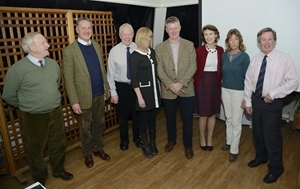 A captivated audience of around 70 people, including Poul Christensen, Chairman of Natural England and well-known BBC wildlife film maker Stephen Moss joined forces to celebrate the first anniversary of the Marlborough Downs Nature Improvement Area at the Marlborough Golf Club last week.
A captivated audience of around 70 people, including Poul Christensen, Chairman of Natural England and well-known BBC wildlife film maker Stephen Moss joined forces to celebrate the first anniversary of the Marlborough Downs Nature Improvement Area at the Marlborough Golf Club last week.
The project, which aims to enhance and protect this wonderful area of Wiltshire chalk downland is a unique landscape-scale conservation project that has received government backing.
This important farmer-led initiative involves a consortium of more than 30 farmers, an army of volunteers and local residents as well as leading wildlife research charity, the Game & Wildlife Conservation Trust and Wiltshire County Council. The project is already attracting wide attention and it is hoped that it will become a blueprint for other large-scale conservation projects across the country.
Jemma Batten, Project Manager for the Marlborough Downs NIA said, “The local enthusiasm for this massive nature conservation project is overwhelming. Already we are seeing results and are delighted that some of our important habitats and wildlife species such as tree sparrows and corn buntings are responding to the extra support that they desperately need.”
At the evening event, Poul Christensen, Chairman of Natural England congratulated the group for their first year’s achievements and said, “It is my great pleasure to meet with the farmers of the Marlborough Downs Nature Improvement Area and help celebrate their first birthday. They have much to celebrate! After a year of hard graft they can demonstrate real progress in creating habitats for wildlife on their farms. Farmers have always produced our food but here, they are clearly demonstrating, in this ground-breaking project, that they can look after our wildlife as well. I wish them every success.”
The project has arranged a busy diary of events throughout the year so that local people, families and school parties can share and enjoy the achievements of this exciting initiative that is helping to conserve this stunning landscape and its precious wildlife. To join in the celebrations, the Marlborough Downs NIA has organised a special day of events on Sunday 9th June as part of Open Farm Sunday. This is a chance to visit the project and take part in walks, nature talks, art demonstrations, sample local food or get close to the farm animals. For more details of events, visit: www.facebook.com/MarlboroughDownsNIA or telephone 01225 718758.
END
Photocaption: The Marlborough Downs NIA has already helped vulnerable species such as tree sparrows, which are benefiting from extra food and the creation of innovative tree sparrow ‘villages’. Pictured: from left to right: Arthur Witchell and Chris Musgrave (MDNIA farmer member), Poul Christensen (Natural England Chair), Jemma Batten (Project Manager), Stephen Moss (BBC Wildlife film maker), Teresa Dent (CEO Game & Wildlife Conservation Trust), Gill Hussey (MDNIA Wildlife Champion) Robert Cooper (MDNIA farmer board chair).
Photocredit: Nick Upton.
Notes to editors
1. Contact for media enquiries
Morag Walker / mwalker@gwct.org.uk / 01425 651000 Mobile: 07736 124097
2. The Marlborough Downs Nature Improvement Area
The Marlborough Downs NIA partnership aims and to improve the condition and connectivity of the ecological network of the area, and to re-connect people to the landscape of the Marlborough Downs. The area is a chalk downland habitat and the partnership is predominantly farmer-led. The NIA aims to apply a bottom-up approach, including restoration of primarily chalk and grassland habitats, positive management of sites, and enabling farmers to deliver with biodiversity benefits. The NIA endeavours to work and engage with local communities and young people not in education, employment or training, to encourage more involvement in the countryside and provide greater awareness of landscape, wildlife and farming.
Watch video: http://www.youtube.com/watch?v=AHhy0A6n3BY
3.The Game & Wildlife Conservation Trust is an independent wildlife conservation charity which has carried out scientific research into Britain’s game and wildlife for the past 70 years. We advise farmers and landowners on improving wildlife habitats and we lobby for agricultural and conservation policies based on science. We employ 20 post-doctoral scientists and 40 other research staff with expertise in areas such as birds, insects, mammals, farming, fish and statistics. We undertake our own research as well as projects funded by contract and grant-aid from Government and private bodies. The Trust is also responsible for a number of Government Biodiversity Action Plan species and is lead partner for grey partridge and joint lead partner for
4. The 12 Nature Improvement Areas
Nature Improvement Areas (NIAs) were set up a year ago as part of the measures introduced in the Government’s Natural Environment White Paper. There are currently 12 NIAs which are large, discrete areas run by local partnerships of land management and conservation organisations and local authorities, overseen by Natural England. NIAs will benefit wildlife, people and economic growth by creating more and better-connected habitats and by enhancing landscapes. They will increase resilience to climate change and support the landscape’s ability to provide natural benefits like flood protection and clean water. The 12 NIAs’ diverse range of locally-led projects are involving and engaging more people with the natural environment. For more information on all 12 NIAs, visit: www.naturalengland.org.uk/nia
In total, NIAs cover an area of 5,000 sq km in England with projects focused in the following areas:
- Birmingham & the Black Country (West Midlands)
- Dark Peak (Derbyshire, South Yorkshire, Greater Manchester, West Yorkshire)
- Dearne Valley (South Yorkshire)
- Greater Thames Marshes (Essex and Kent)
- Humberhead Levels (Yorkshire, Lincolnshire and Nottinghamshire)
- Marlborough Downs (Wiltshire)
- Meres and Mosses of the Marches (Shropshire)
- Morecambe Bay Limestone and Wetlands (Lancashire and Cumbria)
- Nene Valley (Cambridgeshire and Northamptonshire)
- Northern Devon (North Devon)
- South Downs (Hampshire and Sussex)
- Wild Purbeck (Dorset)